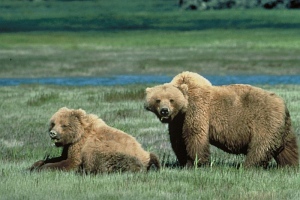 Grizzly bears are iconic Californian mammals -- they're on our state flag; many creeks, hills and passes are named after them; and they're the mascot of many UC schools -- but you won't ever see one out in your backyard or anywhere else in California. Unlike black bears, which are relatively common in the state, grizzlies went extinct in California sometime in the 1920s. The last verified account was an individual shot in 1922 in Tulare County. The species is now restricted to populations that survive well north of California, in Idaho, Montana and through Canada and Alaska.
Grizzly bears are iconic Californian mammals -- they're on our state flag; many creeks, hills and passes are named after them; and they're the mascot of many UC schools -- but you won't ever see one out in your backyard or anywhere else in California. Unlike black bears, which are relatively common in the state, grizzlies went extinct in California sometime in the 1920s. The last verified account was an individual shot in 1922 in Tulare County. The species is now restricted to populations that survive well north of California, in Idaho, Montana and through Canada and Alaska.
The story of what happened to the California grizzly also, by way, tells the history of conservation in this state, as documented in Tracy Irwin Storer's classic book "California Grizzly." Grizzlies evolved in North America along with a suite of other so-called megafauna (basically, mammals over 44 kg) that dispersed across the emergent Bering Strait during low global sea-levels in the past 1 million years or so. The ancestors of grizzlies lived along side saber-toothed cats, mammoths and mastodons, camels and even other bears, like the enormous short-faced faced bear. The short-faced bear probably was a distant relative of grizzlies, but the fossil record of bears from the last million years in North America is unrevealing about the true ancestry of grizzlies. We do know that grizzlies were in California into historical times, with plenty of accounts from Spanish missionaries, American explorers and settlers too. Even into the end of the 19th century, many towns that we now recognize as cities (e.g. Pasadena) had grizzly bear problems. Unfortunately, it seems that humans and grizzlies have long had an antagonistic relationship, with grizzlies losing numbers and habitat to a growing population.
In some ways, then, it's not surprising that the largest species of predatory mammal went extinct , but it is interesting to note that relatively smaller mammals -- raccoons, coyotes and mountain lions -- have survived quite well along the fringes of California urban life. How else have mammal communities changed over the past 100-200 years? How has climate changed played a role? Which mammals are the winners and losers, and can we know? Researchers at UC's Museum of Vertebrate Zoology are actively looking into the details of these questions, and I'll save that for next week. But until then, you can get a preview and poke around:
http://mvz.berkeley.edu/Grinnell/index.html
![]() Nick Pyenson is a PhD candidate at the University of California, Berkeley, in the department of integrative biology and the museum of paleontology.
Nick Pyenson is a PhD candidate at the University of California, Berkeley, in the department of integrative biology and the museum of paleontology.
